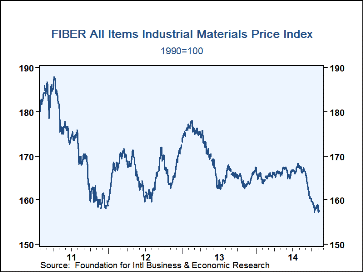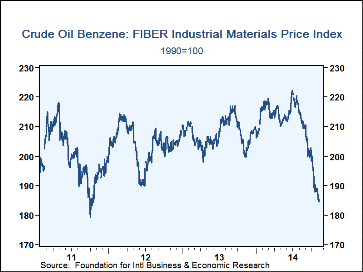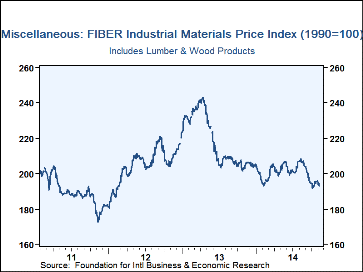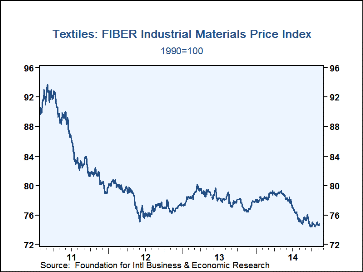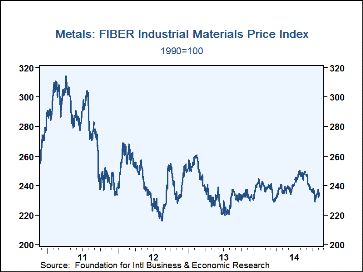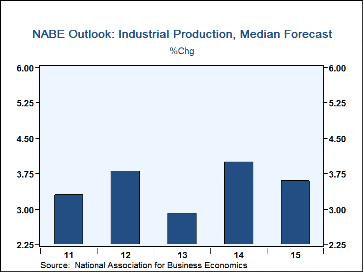 Global| Nov 10 2014
Global| Nov 10 2014FIBER: Industrial Commodity Prices Remain Soft
by:Tom Moeller
|in:Economy in Brief
Summary
There hasn't been enough strength recently in the U.S. industrial sector to fully offset developing economic weakness in the rest of the world. As a result, prices for industrial materials remain under pressure. The industrial [...]
There hasn't been enough strength recently in the U.S. industrial sector to fully offset developing economic weakness in the rest of the world. As a result, prices for industrial materials remain under pressure. The industrial commodity price index, from the Foundation for International Business and Economic Research (FIBER), fell 3.4% as of Friday versus one year ago. Weakness amongst the component series was widespread.
An 8.0% y/y price decline in the crude oil & benzene grouping led the weakness, reflecting a 17.5% y/y decline in the price of WTI crude oil to $77.85 per barrel. That's down by roughly one-quarter from the June high of $107.53. In addition, prices for the petrochemical benzene are down roughly one-third from late-June. Prices in the miscellaneous category also were weak. They've softened 5.0% from last year as natural rubber prices fell roughly one-third y/y. Framing lumber also eased 3.1% y/y. Offsetting these declines was 12.2% y/y increase in random lengths of structural composites. Textile prices also worked 2.7% lower during the last year, paced by a 16.5% y/y decline in cotton prices. A 1.3% y/y increase in burlap prices countered this decline. Metals prices were not as weak, up 0.7% during the last year. Aluminum prices have been buoyant, up 15.6% y/y. Steel scrap prices also gained 1.7% y/y but they're off sharply from the early-year highs. To the downside have been copper scrap prices, off 6.2% y/y.
Future support for commodity prices may be on the way. The current industrial output projection from the National Association for Business Economics calls for 4.0% growth during all of this year, then 3.6% growth in 2015. During the last ten years there has been a 52% correlation between the three-month change in prices and the change in factory sector output.
Commodity price data can be found in Haver's DAILY, WEEKLY, USECON and CMDTY databases.
| FIBER Industrial Materials Price Index (1990=100) | 11/7/14 | Y/Y % | 2013 | 2012 | 2011 |
|---|---|---|---|---|---|
| All Items | 157.65 | -3.4 | 169.0 | 166.4 | 173.0 |
| Textiles | 74.66 | -2.7 | 78.2 | 77.9 | 86.1 |
| Cotton (cents per pound) | 62.06 | -16.5 | 79.6 | 74.5 | 132.8 |
| Metals | 233.59 | 0.7 | 236.3 | 243.0 | 278.7 |
| Aluminum ($ per metric ton) | 2,052.00 | 15.6 | 1,846.3 | 2,019.6 | 2,400.9 |
| Copper Scrap (cents per pound) | 302.97 | -6.2 | 332.4 | 360.6 | 400.3 |
| Steel Scrap ($ per ton) | 341.33 | 1.7 | 346.0 | 366.7 | 412.6 |
| Crude Oil & Benzene | 184.58 | -8.0 | 207.7 | 204.1 | 199.3 |
| Crude Oil (WTI, $ per Barrel) | 77.85 | -17.5 | 97.9 | 94.2 | 95.0 |
| Miscellaneous | 194.52 | -5.0 | 218.3 | 205.3 | 190.6 |
| Framing Lumber ($ per 1000 board ft.) | 377 | -3.1 | 383 | 321 | 273 |
| Natural Rubber (cents per pound) | 117.69 | -35.5 | 189.9 | 211.9 | 262.3 |
Tom Moeller
AuthorMore in Author Profile »Prior to joining Haver Analytics in 2000, Mr. Moeller worked as the Economist at Chancellor Capital Management from 1985 to 1999. There, he developed comprehensive economic forecasts and interpreted economic data for equity and fixed income portfolio managers. Also at Chancellor, Mr. Moeller worked as an equity analyst and was responsible for researching and rating companies in the economically sensitive automobile and housing industries for investment in Chancellor’s equity portfolio. Prior to joining Chancellor, Mr. Moeller was an Economist at Citibank from 1979 to 1984. He also analyzed pricing behavior in the metals industry for the Council on Wage and Price Stability in Washington, D.C. In 1999, Mr. Moeller received the award for most accurate forecast from the Forecasters' Club of New York. From 1990 to 1992 he was President of the New York Association for Business Economists. Mr. Moeller earned an M.B.A. in Finance from Fordham University, where he graduated in 1987. He holds a Bachelor of Arts in Economics from George Washington University.


